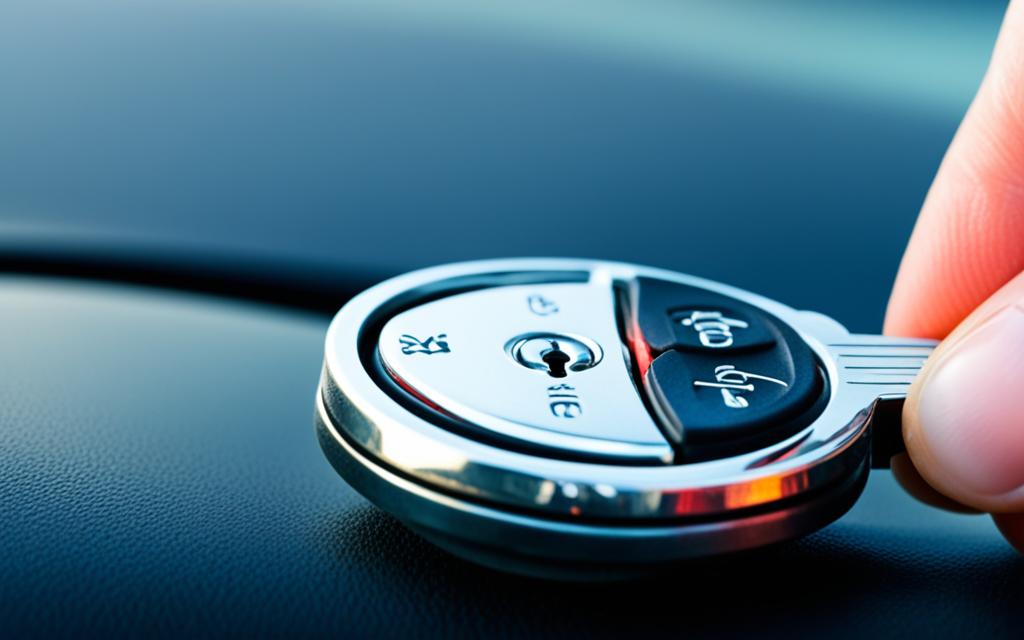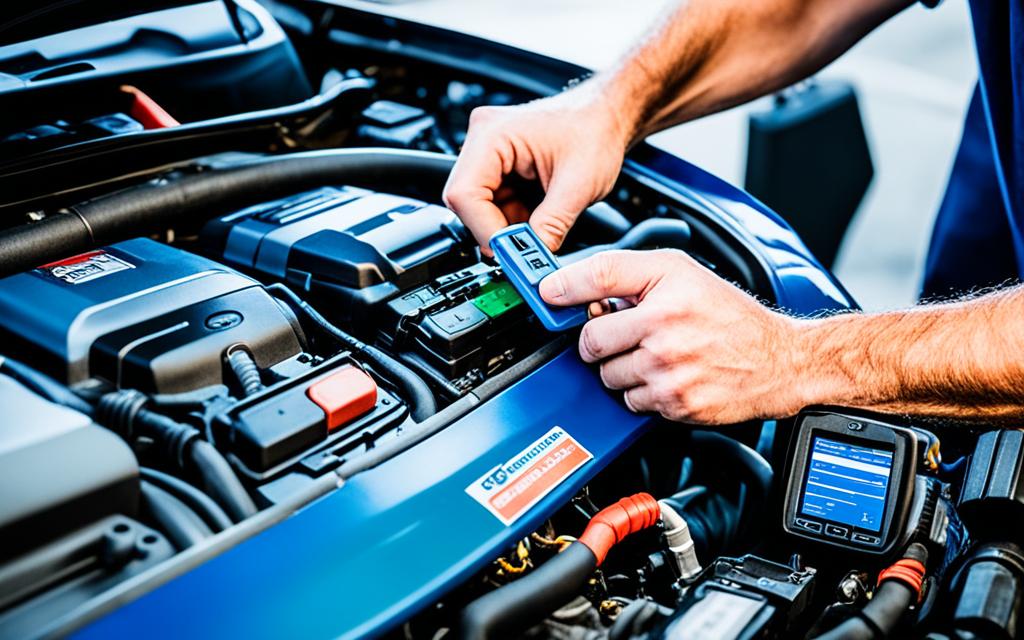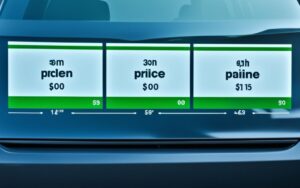If you’re experiencing difficulties starting your car, but your battery is in good condition, it can be frustrating and confusing. You may find yourself wondering why your car won’t start even though the battery is fine. In this article, we will guide you through the troubleshooting process to help you identify the cause of the problem and get your car back on the road.
Starting issues can be caused by various factors, such as problems with the ignition switch, fuel system, electrical connections, ignition system, timing belt or chain, engine control unit (ECU), crankshaft position sensor, engine compression, or fuel injectors. By following the steps and tips provided in this article, you’ll be able to diagnose and resolve the starting problems of your car.
Key Takeaways:
- Starting issues can be caused by various factors, including ignition switch, fuel system, electrical connections, ignition system, timing belt or chain, ECU, crankshaft position sensor, engine compression, and fuel injectors.
- By performing systematic troubleshooting, you can identify and resolve the starting problems of your car.
- If you’re not comfortable with the troubleshooting tasks, it’s recommended to consult a qualified mechanic for assistance.
- Don’t let starting problems keep you off the road – get your car back up and running smoothly!
Checking the Ignition Switch and Starter Motor
When your car struggles to start despite having a fine battery, the ignition switch and starter motor could be the culprits. These two components play a vital role in the starting process.
The ignition switch is responsible for initiating the electrical power to the starter motor, which then cranks the engine to start the car. If either of these parts malfunctions, it can result in starting problems.
Testing the Ignition Switch:
- Make sure the car is in park or neutral and the parking brake is engaged.
- Turn the ignition key to the start position and listen for a click or any strange noise. If you hear neither, it indicates a faulty ignition switch.
- If there is a clicking sound but the engine does not start, the ignition switch may still be defective.
- You can also use a multimeter to test the ignition switch for continuity. Consult your vehicle’s manual for specific instructions.
Inspecting the Starter Motor:
- Locate the starter motor, typically found near the bottom of the engine.
- Check for loose or corroded electrical connections. Ensure all wires are securely attached.
- If the connections are intact, tap the starter motor with a wrench or similar tool to see if it starts working. If it does, it may be a sign of a defective starter motor.
- If tapping does not resolve the issue or the starter motor exhibits other symptoms like grinding or whirring noises, it may need to be replaced.
Remember, if you are uncomfortable performing these tests or need further assistance, it is recommended to consult a qualified mechanic.
Assessing the Fuel System
When your car hesitates to start or the engine cranks but won’t start, it can be frustrating, especially when the battery is fine. In some cases, the culprit may be a faulty fuel system. Assessing the fuel delivery is essential for troubleshooting car starting issues. This section will guide you through diagnosing and troubleshooting common fuel system problems.
Diagnosing Fuel Pump Issues
A failing fuel pump can prevent your car from starting smoothly. To check if the fuel pump is the underlying issue, follow these steps:
- Turn the ignition key to the “ON” position without starting the engine.
- Listen for a humming sound near the fuel tank, which indicates that the fuel pump is functioning correctly.
- If you don’t hear any sound, it could indicate a faulty fuel pump that needs to be replaced.
If the fuel pump is working properly, it’s essential to inspect the fuel filters for any clogs that may restrict fuel flow.
Inspecting Clogged Fuel Filters
Clogged fuel filters can obstruct fuel flow to the engine, causing starting difficulties. To check for clogged fuel filters, follow these steps:
- Locate the fuel filter, usually found along the fuel line or near the fuel tank.
- Disconnect the fuel line from the filter and inspect the filter for signs of debris or clogs.
- If the filter appears dirty or clogged, it’s necessary to replace it with a new one.
Did you know? A clogged fuel filter not only affects starting but can also lead to poor engine performance and decreased fuel efficiency.
Regularly changing the fuel filter as part of your car’s maintenance routine can prevent starting issues caused by clogs.
Image of a Fuel Pump
| Symptoms of Fuel System Problems | Possible Causes |
|---|---|
| Car hesitates to start | 1. Faulty fuel pump 2. Clogged fuel filters 3. Fuel line blockages |
| Engine cranks but won’t start | 1. Fuel pump failure 2. Fuel pressure regulator issues 3. Ignition system problems |
| Car struggles to start but battery is fine | 1. Clogged fuel injectors 2. Fuel pump relay malfunction 3. Fuel pressure regulator failure |
Keep in mind that other factors, such as fuel line blockages or faulty fuel pressure regulators, can also contribute to starting issues. Testing and inspecting the fuel system is crucial in resolving these problems and getting your car back on the road.
Checking the Electrical Connections
When your car struggles to start, even though the battery is fine, electrical issues could be to blame. Loose or corroded electrical connections can disrupt the flow of power, preventing your car from starting properly. To troubleshoot this problem, follow these steps to inspect and clean your car’s electrical connections:
Step 1: Disconnect the Battery
Before inspecting any electrical connections, it’s important to disconnect the battery. This ensures your safety and prevents any accidental short circuits. Use a wrench or socket to loosen the negative (-) terminal first, followed by the positive (+) terminal.
Step 2: Inspect the Battery Terminals
After disconnecting the battery, visually examine the terminals for any signs of corrosion or buildup. Corroded terminals can hinder electrical conductivity and cause starting issues. If you notice corrosion, you can clean the terminals using a mixture of baking soda and water. Apply the solution to the terminals using a small brush, then rinse with clean water and dry thoroughly.
Step 3: Inspect Other Electrical Connections
Aside from the battery terminals, there are other electrical connections in your car that can affect the starting process. Check the connections at the starter motor, alternator, and ignition switch for any signs of looseness or corrosion. Use a wrench or socket to ensure that all connections are tight and secure.
Pro Tip: When inspecting electrical connections, pay close attention to the wires as well. Look for any frayed or damaged wires that may need repairing or replacement.
Step 4: Clean the Connections
If you notice any corrosion or buildup on the connectors or wires, you can clean them using a wire brush or sandpaper. Gently scrub the affected areas until they are clean and shiny. Be careful not to damage the connectors or wires during this process.
Step 5: Reconnect the Battery
Once you have inspected and cleaned all the electrical connections, it’s time to reconnect the battery. Start by connecting the positive (+) terminal first, followed by the negative (-) terminal. Ensure that the connections are secure and tight.
By following these steps, you can troubleshoot and resolve electrical issues affecting your car’s starting process. Maintaining clean and secure electrical connections is essential for a reliable electrical flow, ensuring that your car starts smoothly every time.
| Common Electrical Issues | Possible Symptoms |
|---|---|
| Loose battery terminal connections | Intermittent starting problems, flickering lights |
| Corroded battery terminals | Difficulty starting, dim headlights |
| Loose or corroded connections at starter motor | Clicking sound when turning the key, no response from starter motor |
| Loose or corroded connections at alternator | Charging system warning light, battery not charging |
| Loose or corroded connections at ignition switch | No response when turning the key, intermittent starting problems |
Investigating the Ignition System
When your car experiences starting issues, it could be due to malfunctioning ignition components, such as spark plugs or ignition coils. These components play a crucial role in initiating the combustion process and getting your engine running. If they are not functioning properly, your car may struggle to start, even with a good battery. In this section, we will guide you through the process of testing and troubleshooting these ignition system parts to determine if they are causing the problem.
Testing Spark Plugs
Spark plugs are responsible for igniting the air-fuel mixture in the engine cylinders. Over time, they can become worn or fouled, resulting in poor combustion and difficulty starting the car. To test your spark plugs:
- Carefully remove each spark plug from its cylinder.
- Inspect the condition of the electrodes and the spark plug gap. Look for signs of wear, corrosion, or buildup.
- If necessary, clean the spark plugs using a wire brush or replace them if they are damaged or worn beyond repair.
- Reinstall the spark plugs and ensure they are properly tightened.
By testing and maintaining your spark plugs, you can ensure a strong and consistent spark, improving your car’s starting capabilities.
Checking Ignition Coils
Ignition coils are responsible for generating the high voltage needed to create a spark at the spark plugs. A faulty ignition coil can lead to weak or no spark, causing your car’s engine to crank but not start. To check your ignition coils:
- Locate the ignition coils, typically found near the spark plugs.
- Disconnect the electrical connectors from the ignition coils.
- Using a multimeter, measure the resistance of each coil. Refer to your vehicle’s service manual for the specific resistance values.
- If a coil has significantly higher or lower resistance than the specified range, it may be faulty and should be replaced.
Testing your ignition coils can help identify any issues that may be preventing your car from starting.
Quote:
“The ignition system is like the heart of your car. If it’s not functioning properly, your car won’t start or run smoothly.” – Car Expert

Checking the Timing Belt or Chain
If your car is experiencing starting issues, such as the engine cranking but not starting or the vehicle not starting even with a good battery, it’s essential to consider the condition of the timing belt or chain. A worn or broken timing belt or chain can lead to starting problems and should be inspected regularly.
Inspecting the timing belt or chain requires attention to detail and knowledge of your specific vehicle’s engine design. Here are the steps to follow:
- Consult your vehicle’s owner manual to determine the recommended timing belt or chain replacement interval. It’s crucial to adhere to this schedule to prevent potential damage to the engine.
- Locate the timing belt or chain cover. You may need to remove engine covers or other components to access it.
- Visually inspect the timing belt or chain for any signs of wear, such as cracks, fraying, or missing teeth. Pay close attention to the condition of the belt or chain near the engine pulleys and tensioner.
- If you suspect a problem with the timing belt, you can perform a physical inspection by carefully removing it from the engine. However, if you’re not confident in your abilities, it’s best to consult a qualified mechanic for this task.
- If necessary, replace the timing belt or chain with a new one. Ensure you use a high-quality replacement part that is compatible with your vehicle’s engine.
By regularly inspecting and replacing the timing belt or chain as needed, you can prevent potential starting issues and ensure the longevity of your engine.
“A worn or broken timing belt or chain can lead to starting problems.”
Inspecting the timing belt or chain is a critical step in troubleshooting car starting problems. By following the recommended maintenance schedule and paying attention to any signs of wear, you can address the issue proactively and avoid costly repairs in the future.
Assessing the Engine Control Unit (ECU)
When your car is experiencing starting problems, the Engine Control Unit (ECU) is a critical component to consider. The ECU is responsible for managing various engine functions, including the ignition system and fuel injection. If there are issues with the ECU, it can affect the starting process of your vehicle.
To diagnose potential problems with the ECU, follow these steps:
- Check for Error Codes: Use a car diagnostic tool to scan for error codes stored in the ECU. These codes can provide insight into specific issues affecting the starting system.
- Inspect Wiring Connections: Ensure that the wiring connections to the ECU are secure and free from corrosion or damage. Loose or faulty connections can disrupt the ECU’s functionality.
- Test Voltage Supply: Measure the voltage supply to the ECU using a multimeter. A weak or fluctuating voltage can indicate a problem with the power source or the ECU itself.
- Consult a Professional: If you’re unable to identify any issues with the ECU on your own, it’s recommended to seek assistance from a qualified mechanic or an automotive specialist.
In some cases, repairing or replacing the ECU may be necessary to resolve the starting problems. A professional technician can accurately diagnose the issue and determine the best course of action.
To better understand the role of the ECU in the starting process, consider the following:
The Engine Control Unit (ECU) acts as the brain of your vehicle, analyzing inputs from various sensors and making adjustments to ensure optimal engine performance. When starting your car, the ECU receives signals from the ignition switch and other components to initiate the ignition sequence. If there’s a malfunction in the ECU, it can disrupt this process, resulting in starting issues.
For a visual reference, here’s an image of an Engine Control Unit:

Testing the Crankshaft Position Sensor
The crankshaft position sensor is a crucial component that provides vital information to the engine’s computer. If you’re experiencing car starting problems and your engine cranks but won’t start, the crankshaft position sensor could be the culprit. In this section, we will walk you through the process of testing this sensor and troubleshooting any issues that may arise.
“The crankshaft position sensor is like the eyes and ears of your car’s engine. It detects the position and rotational speed of the crankshaft and sends this information to the engine control module.”
Before starting the testing process, keep in mind that the exact steps may vary depending on your car make and model. It’s always a good idea to consult your vehicle’s manual or seek professional help if needed.
Gathering the necessary tools
Before testing the crankshaft position sensor, gather the following tools:
- Multimeter
- Wrench or socket set
- Electrical connectors and wiring diagram for your car
Step-by-step procedure for testing the crankshaft position sensor
Follow these steps to test the crankshaft position sensor:
- Locate the crankshaft position sensor. It is typically located near the crankshaft pulley or the flywheel.
- Disconnect the electrical connector from the sensor.
- Using a multimeter, set it to measure resistance or impedance. Connect the multimeter to the terminals of the sensor.
- Compare the resistance or impedance reading with the specifications provided in your vehicle’s manual or by the manufacturer. If the reading is outside the acceptable range, the sensor may be faulty and should be replaced.
- Inspect the sensor and its wiring for any signs of damage, such as frayed wires or corrosion. Replace or repair any damaged components.
- Reconnect the electrical connector to the sensor.
Testing the crankshaft position sensor will help you determine if it is functioning correctly and whether it is the underlying cause of your car’s starting problems. If the sensor passes the test but you’re still experiencing starting issues, it’s advisable to seek professional assistance to further diagnose the problem.
| Signs of a faulty crankshaft position sensor | Possible causes |
|---|---|
| Intermittent starting issues | Faulty sensor or wiring issues |
| No start condition | Failed sensor |
| Engine misfires or runs rough | Erratic signal from the sensor |
| Lack of power or engine stalling | Sensor sending incorrect signals to the engine control module |
Next, we’ll move on to Section 9, where we will discuss checking for engine compression issues. This step is crucial in identifying potential problems that may affect your car’s starting capabilities.
Checking for Engine Compression Issues
If your car continues to experience starting difficulties despite having a good battery and a working ignition system, engine compression issues may be the culprit. Engine compression refers to the pressure created when the air-fuel mixture is compressed inside the cylinders before combustion. Low or uneven engine compression can hinder the combustion process, making it difficult for the engine to start.
The best way to determine engine compression is by performing a compression test. Here’s how you can do it:
- Ensure that your car’s engine is cool before starting the test.
- Remove the spark plugs and disconnect the ignition system to prevent the engine from starting.
- Connect a compression gauge to the first cylinder and have an assistant crank the engine several times.
- Record the reading on the compression gauge for that cylinder.
- Repeat the process for each cylinder and compare the readings.
An ideal compression reading will vary depending on the make and model of your vehicle. However, a significant difference in compression readings between cylinders or readings below the manufacturer’s specifications can indicate compression issues.
Interpreting Compression Test Results
When interpreting compression test results, keep the following in mind:
- If all cylinders have low compression, it may indicate a worn piston rings or cylinders, or a leaking head gasket.
- If only one or two cylinders have low compression, it may suggest a problem with the valves or piston rings in those specific cylinders.
Consult your vehicle’s service manual or a trusted mechanic to determine the acceptable compression range for your specific engine. They will be able to provide you with further guidance and recommend the appropriate repairs if issues are detected.
It’s important to address engine compression issues promptly, as they can lead to poor engine performance, decreased fuel efficiency, and potential damage to other engine components.
| Signs of Engine Compression Issues | Possible Causes |
|---|---|
| Difficulties starting the engine | Worn piston rings, faulty valves, leaking head gasket |
| Decreased power and acceleration | Engine wear, damaged cylinders, malfunctioning valves |
| Inconsistent engine performance | Uneven compression across cylinders, worn piston rings |
Inspecting the Fuel Injectors
If your car is struggling to start, even with a good battery, the issue could be related to clogged or faulty fuel injectors. These components play a crucial role in fuel delivery and can hinder the starting process if they are not functioning properly.
To ensure optimal performance, it’s important to inspect and clean the fuel injectors. Here’s a step-by-step guide to help you through the process:
- Start by locating the fuel rail, which contains the fuel injectors. It is usually located near the intake manifold.
- Disconnect the electrical connections and remove the fuel rail from the engine.
- Carefully remove each fuel injector from the fuel rail.
- Inspect the injectors for any signs of clogging, such as dirt or debris buildup. If clogged, you can use a specialized injector cleaner to remove any deposits.
- Using a soft brush, clean the injector nozzles to ensure they are free from any obstructions.
- Check the injector seals for any signs of damage or leaks. Replace them if necessary.
- Before reinstalling the injectors, apply a small amount of lubricant to the o-rings to ensure a tight seal.
- Reassemble the fuel rail and reconnect the electrical connections.
- Start your car and monitor its performance. If the starting issues persist, further diagnosis may be required.
Inspecting and cleaning the fuel injectors can help resolve starting issues caused by fuel delivery problems. Regular maintenance and cleaning can also improve overall engine performance and fuel efficiency.
Remember: If you’re not comfortable performing these tasks yourself, it’s always recommended to seek the assistance of a qualified mechanic.
Note:
The process of inspecting and cleaning fuel injectors may vary depending on the make and model of your vehicle. Always consult your car’s manual or seek professional advice for specific instructions.
Fuel Injector Inspection Results:
| Injector | Condition |
|---|---|
| Injector #1 | No signs of clogging |
| Injector #2 | Clogged with debris |
| Injector #3 | No signs of clogging |
| Injector #4 | No signs of clogging |
Considering Other Possible Causes
If you’ve gone through the troubleshooting steps for your car’s starting issues and the battery is in good condition, but the problem still persists, there may be other underlying causes to consider. Sometimes, the issue can be related to sensor malfunctions or even problems with the security system.
Modern cars are equipped with various sensors that monitor different systems and components. These sensors provide crucial data to the car’s computer, which helps in determining the optimal fuel mixture, ignition timing, and other parameters for efficient starting and performance. If any of these sensors malfunction, it can affect the starting process.
One common sensor that can cause starting problems is the crankshaft position sensor. This sensor detects the position and speed of the crankshaft and provides the information to the engine control unit (ECU). If the crankshaft position sensor is faulty or sending incorrect signals, it can prevent the engine from starting.
Another possible cause for starting issues could be related to the vehicle’s security system. If the security system has a malfunction or is not properly disarmed, it can prevent the car from starting. In some cases, you may need to reset the security system or have it inspected by a professional.
It’s important to note that troubleshooting car starting problems can be complex, and it may require specialized knowledge and diagnostic tools. If you’ve exhausted all the possible causes and are still unable to resolve the issue, it’s recommended to seek assistance from a qualified mechanic or automotive technician.
“When troubleshooting car starting problems, it’s essential to consider all possible causes, including sensor malfunctions and issues with the security system. Seeking professional help is always a smart choice if you’re unable to resolve the issue on your own.”
To summarize, car starting issues can be caused by various factors. When the battery is in good condition but the car won’t start, it’s important to consider other possible causes such as sensor malfunctions and problems with the security system. If you’re unsure or unable to diagnose and fix the problem yourself, it’s best to consult a qualified mechanic for assistance.
Possible Causes of Car Starting Issues
| Cause | Description |
|---|---|
| Faulty Sensors | Malfunctioning sensors can affect the starting process, such as the crankshaft position sensor. |
| Security System Issues | Problems with the security system can prevent the car from starting if it is not properly disarmed or has a malfunction. |
| Other Electrical Problems | Issues with other electrical components, such as wiring or fuses, can also interfere with the starting process. |
Image: A car with starting issues. Troubleshooting car starting problems can be complex and may require professional assistance.
Conclusion
Troubleshooting a car that struggles to start when the battery is fine can be challenging. However, by following the steps outlined in this article, you can systematically identify and resolve the issue. Whether it’s checking the ignition switch and starter motor, assessing the fuel system, inspecting the electrical connections, investigating the ignition system, or analyzing other possible causes, each section provides valuable insights and guidance.
However, if you’re not comfortable performing these troubleshooting tasks yourself, it’s always best to consult a qualified mechanic for assistance. They have the expertise and specialized tools to diagnose and fix complex car starting issues. Don’t let starting problems keep you off the road – with the help of a professional, you can get your car back up and running smoothly in no time.
Remember, regular maintenance and servicing can also prevent or minimize starting problems. Make sure to schedule routine check-ups with a trusted mechanic and address any issues promptly to maintain the longevity and reliability of your vehicle. With a little proactive care and troubleshooting know-how, you’ll be able to start your car without any hassle and enjoy a smooth driving experience.
FAQ
Why is my car struggling to start even though the battery is fine?
There are several possible reasons for this issue. It could be due to problems with the ignition switch, starter motor, fuel system, electrical connections, ignition system, timing belt or chain, engine control unit (ECU), crankshaft position sensor, engine compression, fuel injectors, or other factors. It’s important to troubleshoot and diagnose the specific cause to resolve the starting problem.
How can I check the ignition switch and starter motor?
To test the ignition switch, try turning the key to the “on” position and checking if the dashboard lights and accessories activate. To inspect the starter motor, listen for a clicking noise when you turn the key, indicating that the starter motor is engaging. If you suspect either component is faulty, consult a mechanic for further inspection and potential replacement.
What should I do if my car hesitates to start or the engine cranks but won’t start?
These symptoms can indicate fuel system issues. Start by checking the fuel pump and fuel filter for any clogs or malfunctions. It’s also helpful to test the fuel pressure and inspect the fuel injectors. If necessary, clean or replace these components to restore proper fuel delivery and resolve the starting problem.
How can I check the electrical connections in my car?
Begin by visually inspecting the battery terminals and cables for any signs of corrosion or looseness. Tighten any loose connections and clean any corrosion using a wire brush and battery cleaner. Additionally, check other electrical connections, such as those related to the starter motor, ignition system, and ECU. Ensure they are secure and free from corrosion or damage to ensure optimal electrical flow.
What should I do if my car’s ignition components are causing starting issues?
Start by testing the spark plugs and ignition coils. If the spark plugs are worn or damaged, replace them with new ones. Faulty ignition coils should also be replaced. These components are crucial for generating the spark that ignites the fuel mixture in the engine, so ensuring their proper function is essential for reliable starting.
How can I inspect the timing belt or chain in my car?
In most cases, it is best to consult a mechanic for a thorough inspection of the timing belt or chain. Signs of a worn or broken timing belt or chain include engine misfires, loud noises coming from the engine, or difficulty starting the vehicle. If you notice any of these symptoms, have the timing belt or chain inspected and replaced if necessary.
How can I diagnose problems with the Engine Control Unit (ECU)?
Diagnosing ECU issues often requires specialized equipment and expertise. If you suspect an issue with the ECU, it is best to consult a qualified mechanic or an automotive technician who can perform a diagnostic test using professional-grade equipment to identify any faults. They can then determine if the ECU needs to be repaired or replaced.
How do I test the crankshaft position sensor?
Testing the crankshaft position sensor typically involves using a digital multimeter to measure voltage or resistance at different points of the sensor. The specific testing procedure can vary depending on the make and model of your vehicle, so it’s best to consult the vehicle’s service manual or seek assistance from a mechanic to perform this test accurately.
How can I check for engine compression issues?
Performing a compression test involves using a compression gauge to measure the compression levels in each cylinder of the engine. Low or uneven compression can indicate issues with the engine’s valves, piston rings, or cylinder head gasket. If you suspect compression problems, consult a mechanic to perform a compression test and provide further guidance on potential repairs.
What should I do if my fuel injectors are causing starting problems?
If you suspect fuel injector issues, you can inspect them visually for any signs of clogging or damage. Additionally, consider using a fuel injector cleaner or having them professionally cleaned. If cleaning does not resolve the starting issue, it may be necessary to replace the fuel injectors to ensure proper fuel delivery.
What other factors could be causing my car’s starting problems?
If you have checked and ruled out all the previously mentioned components, there may be other underlying causes for your car’s starting difficulties. Sensor malfunctions, issues with the security system, or even problems with the electronic key or immobilizer can interfere with the starting process. Consult a mechanic to further explore these possibilities and find a resolution.








